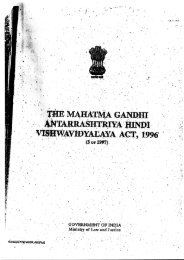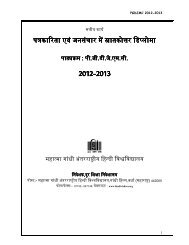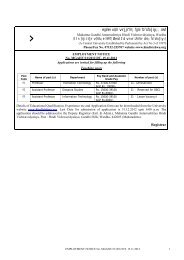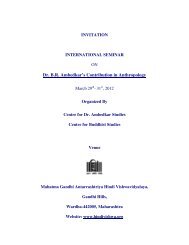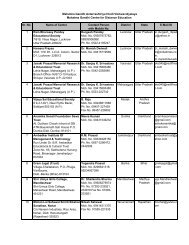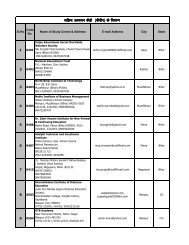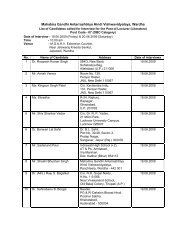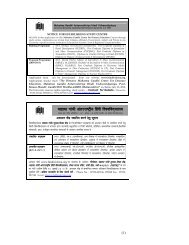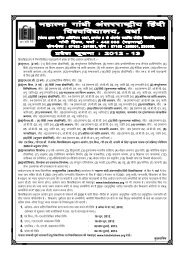A Journal of Mahatma Gandhi Antarrashtriya Hindi Vishwavidyalaya
A Journal of Mahatma Gandhi Antarrashtriya Hindi Vishwavidyalaya
A Journal of Mahatma Gandhi Antarrashtriya Hindi Vishwavidyalaya
You also want an ePaper? Increase the reach of your titles
YUMPU automatically turns print PDFs into web optimized ePapers that Google loves.
proved to be a political suicide for him.<br />
The 14th Nov., 1908 issue <strong>of</strong> <strong>Hindi</strong> Kesri<br />
enclosed a comment :<br />
“By seeking pardon, Sapreji has ruined<br />
his political and public life’’.<br />
After his release, Sapreji lived in mental<br />
agony- tortured with a sense <strong>of</strong> shame,<br />
guilt, remorse and self abasement. Living<br />
in seclusion, for a year, in Ramdasi Monastry<br />
in Hanuman Garh. He earned his bread<br />
by begging. During this period, he studied<br />
and translated Samarth Ramdas, famous<br />
book “Dasbodh”. He tried to propagate<br />
the spirit <strong>of</strong> Renaissance but changed his<br />
modus-operandi. Renaissance is a process<br />
<strong>of</strong> re-awakening, a growth <strong>of</strong> wisdom and<br />
knowledge in every field. Another very<br />
important aspect <strong>of</strong> Renaissance was<br />
delving deep into ancient classical literature<br />
and art and interpreting it in modern<br />
context, thus throwing a new light on<br />
it. It was through his translations that<br />
Madhav Rao Sapre tried to throw a new<br />
light on the ancient texts. With this<br />
objective, he translated ‘Dasbodh’ in 1910.<br />
Its first edition was published in 1912.<br />
Vishwanath Kashinath Rajwade in his article<br />
on ‘Ramdas’ has given a detailed and vivid<br />
description <strong>of</strong> ‘Dasbodh’. Sapreji’s article<br />
on ‘Dasbodh’ is greatly influenced by the<br />
latter. Another important translation done<br />
by Madhav Rao Sapre was <strong>of</strong> ‘Gita Rahasya’<br />
by Tilak in 1950. Although, this book has<br />
been translated into many languages, the<br />
first translation was in <strong>Hindi</strong>. More than<br />
twenty five editions <strong>of</strong> this book have<br />
been published. It had a tremendous impact<br />
on <strong>Hindi</strong> literature.<br />
The third important translation done<br />
by Sapreji is ‘Mahabharata Mimansa’ which<br />
is a translation <strong>of</strong> Chintamani Vinayak<br />
Vaidya’s ‘Mahabharata ke Upsanghar’.<br />
Similar to other translations, here too<br />
Sapreji has given a detailed account <strong>of</strong><br />
the author, period <strong>of</strong> composition, poetic<br />
style, narrative technique etc. A deep study<br />
<strong>of</strong> this translation reveals Sapreji’s depth<br />
<strong>of</strong> knowledge in Sanskrit. Another<br />
outstanding feature <strong>of</strong> Renaissance was<br />
the growth in the spirit <strong>of</strong> nationalism.<br />
In India, this was expressed in various<br />
ways, in different fields <strong>of</strong> learnings. Its<br />
greatest impact was seen in rise against<br />
Colonialism. After a long wait India was<br />
seen rising from its torpor. The tendency<br />
to self-introspect was an outgrowth <strong>of</strong> this<br />
phenomenon. Its aim too, is to strengthen<br />
and sharpen the anti-colonial movement.<br />
It has already been stated earlier that<br />
the Renaissance ushered in ‘ a brave new<br />
world’. Every branch <strong>of</strong> knowledge was<br />
explored. Acquaintance with classical<br />
literature increased. The immense vitality<br />
<strong>of</strong> the age, left nothing untouched— science,<br />
social science, art, adventure, world<br />
strirring events engrossed the mind <strong>of</strong><br />
the newly-awakened people. New values<br />
were established, new perspectives<br />
developed. It reached the shores <strong>of</strong> Bengal.<br />
Here, its effect was more pervasive than<br />
in the <strong>Hindi</strong> speaking belt—touching every<br />
14 :: January-March 2012




